(Upload on November 12 2022) [ 日本語 | English ]
Mount Usu / Sarobetsu post-mined peatland
From left: Crater basin in 1986 and 2006. Cottongrass / Daylily
HOME > Lecture catalog / Research summary > Glossary > Invertebrate > Insect
[vermin, Field trip (flora and fauna), mammal, plant taxonomy]
Animalia > Phylum Arthropoda (節足動物門) > Hexapoda (六脚亜門)Class Insecta (L. 1758) (昆虫綱)= a three-parted body = head + thorax (+ three pairs of legs) + abdomenLife history (生活史)Ametabola: no metamorphosis = egg → larva/imagoHemimetabola: incomplete metamorphosis
egg → larva → nymph nymph → imago(adult) = egg → larva → pupa, chrysalis/nymph → imago |
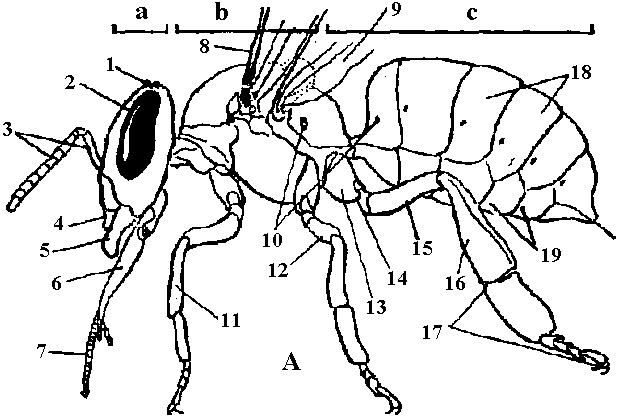 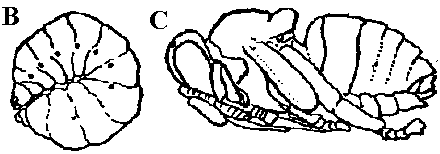 Apis mellifera L. (Worker)
Apis mellifera L. (Worker)A. Profile: a. head, b. thorax, c. abdomen, 1. ocellus 2. compoundeye 3. antenna 4.labrum, 5. mandible, 6. maxilla, 7. labial glossa, 8. fore wing, 9. hind wing, 10. spiracies, 11. fore-leg, tibia 12. mid-leg, femur, 13-17. hind-legs, 13. coxa, 14. trochanter, 15. femur, 16. tibia, 17. tarsi, 18. abdominal terga 19. abdominaI sterna B: mature larva C: pupa (B, C: profile) (by Sakagami SF)
|
Subclass Apterygota (無翅亜綱)= Ametabolano wings (essentially), no metamorphosis Order Diplura (内顎類)diplurans (コムシ)after Devonian Order Protura (原尾類)proturans (カマアシムシ)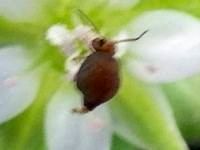
Order Collembola (トビムシ)springtails, snow-fleasafter Devonian Order Thysanura (総尾目)after TriassicLepisma (シミ) silver-fish Subclass Pterygota (有翅亜綱)metabolaDivision Palaeoptera (古翅群)hemimetabolous metamorphosis (不完全変態)Order Ephemeroptera (Ephemerida, 蜉蝣/カゲロウ, mayflies)after Permian, > 2000 speciesEphemera (カゲロウ), Epeorus (ヒラタカゲロウ) 
 Larvae: antennae short and bristle-like four to nine parts of leaf-like or fan-like gills along the sides of the abdomen three (two) long filaments at the rear of abdomen one claw Adult: antennae short and bristle-like front leges long and often held out in front of body compound eyes large, usually covering most of the head four membranous wings with many veins and crossveings front wings large, triangular hind wings smaller, fan-shapded abdomen slender, bearing two (or three) long terminal filaments Order Odonata (蜻蛉)≈ 5000 species worldwidecarnivorous Suborder Zygoptera (均翅) dameselflies  Coenagrionidae (イトトンボ)
Coenagrionidae (イトトンボ)Enallagma (ルリイトトンボ): E. circulatum Selys 1883 (ルリイトトンボ) Platycnemididae (モノサシトンボ) Lestidae (アオイトトンボ) Megapodagrionidae (ヤマイトトンボ)  Calopterygidae (カワトンボ), broad-winged damselfly or jewelwing
Calopterygidae (カワトンボ), broad-winged damselfly or jewelwingCalopteryx (アオハダトンボ) Matrona (タイワンハグロトンボ) Mnais (カワトンボ): M. costalis Selys 1869 (ニホンカワトンボ) Psolodesmus (クロイワカワトンボ) Euphaeidae (ミナミカワトンボ) Euphaea (ミナミカワトンボ) Bayadera (ヒメカワトンボ) Chlorocyphidae (ハナダカトンボ) Suborder Anisozygoptera (ムカシトンボ) |
Suborder Anisoptera (不均翅, 真トンボ) dragonflies, mosquito-haws underwing wider than forewing Aeshnidae (ヤンマ) Austropetaliidae (オセアニアベニボシヤンマ) Chlorogomphidae (ミナミヤンマ) Cordulegastridae (オニヤンマ) Corduliidae (エゾトンボ) Gomphidae (サナエトンボ) Libellulidae (トンボ) Sympetrum frequens Selys 1883 (アキアカネ) Neopetaliidae (ベニボシヤンマ) Petaluridae (ムカシヤンマ) Phylum Neoptera (新翅群)Section Polyneoptera (多新翅群)hemimetabolaOrder Blattoidea (網翅, ゴキブリ)roaches, cockroaches, croton-bugsafter Carboniferous Blatta (ゴキブリ) Order Mantodea (カマキリ)praying-mantis, mantis, smoothsayersafter Paleozoic Mantis/Paratenodera (カマキリ) Order Isoptera (等翅, シロアリ)termites, white antafter Eocene (after Jurassic proposed by Nelepa & Bandi 2000) 2600 species in the 281 genera of 7 families Termitidae (シロアリ) Termes (シロアリ), Leucotermes (ヤマトシロアリ), Coptotermes (イエシロアリ) Order Zoraptera (絶翅)zorapterans (Zorotypus)Order Plecoptera (襀翅/カワゲラ)stone-flies, salmon flies after Permian, > 2000 species, incomplete metamorphosis (hemimetaboly)Perla / Neoperla / Isoperla (カワゲラ) 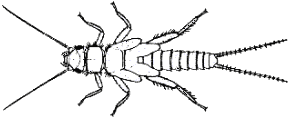
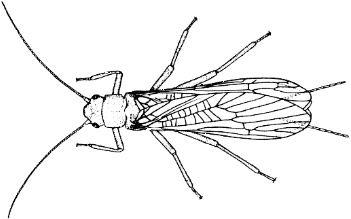 Larvae: Antennae long, filiform Body flattened, leges widely separated Tracheal gills present as tufs behind the head, at the base of legs or around the anus EAch segement of thorax is covered by a large dorsal sclerite Ceric long, multi-segment two tails and two crows Adult: antennae long, filiform front wings long and narrow; M-Cu crossveins form distinctive boxes near center of front wing hind wings shorter than the front wings; basal area of hind wing enlarged and pleated cerci long, multi-segmented horizontally well folded wings Order Grylloblattoidea (ガロアムシ)grylloblattidsGalloisiana (ガロアムシ), Grylloblatta Order Phasmida (ナナフシ)after TriassicPhraortes (ナナフシ) walking-stick, stick-insect Micadina (トビナナフシ) Phyllium (コノハムシ) leaf-insect Carausius (= Dixippus): parthenogenesis (virgin birth), for laboratory use Order Orthoptera (直翅目)katydids, crickets, grasshoppers, locustsOrder Embioptera (シロアリモドキ)embiidsafter Oligocene Embia, Oligotoma (シロアリモドキ) webspinners |
Order Dermaptera (ハサミムシ), earwigafter Jurassic (19000 species in 10 familes)Forficula / Anisolabis (ハサミムシ) earwigs, Hemimerus Section Paraneoptera 側新翅= Hemimetabola (不完全変態類/半変態類)Order Psocoptera (チャタテムシ)= CorrodentiaSuborder Phthiraptera (シラミ) = Siphunculata lice (sg. louse), sucking lice Larva-imago (adult) - haematophagy: sucking blood from mammalian skin high host-specific: each species: each species parasitizes on the specific hots and lives its entire life on the host
Major human parasite species: Order Thysanoptera (アザミウマ)Order Hemiptera (半翅/セミ)= RhynchotaSection Oligoneoptera (乏新翅類)= HolometabolaOrder Neuroptera (脈翅), lacewingsafter PermianProtohermes (ヘビトンボ) dobson-fly, snake-fly. Chrysopa (クサカゲロウ) green lace-wing, golden eye Order Mecoptera (長翅)scorpion-fliesafter Permian Panorpa (シリアゲムシ) Order Trichoptera (毛翅/トビケラ)caddis flies, trout-flies, case-fliesafter Jurassic, > 7,00 species, complete metamorphosis (holometabolism) Rhyacophila (ナガレトビケラ), Limnophilus (トビケラ), Phryganea ツマグロトビケラ, Goera ニンギョウトビケラ 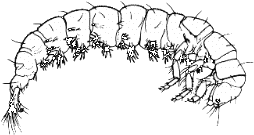
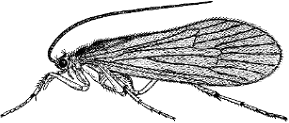 Larva (nymph): Eruciform (catapilar-like) body; abdomen usually enclosed in a case made of stones, leaves, twigs, etc. head capsule well-developed with chewing mounthparts thread-like abdominal gills usually present in case-makers one pair of hooked prolegs often present at a tip of abdomen Adult: Filiform antennae Mouthparts reduced or vestigal Two pairs of wings clothed with long hair Wings held tent-like over the abdomen Order Lepidoptera (鱗翅/チョウ)Order Diptera (双翅/ハエ)Order Aphaniptera 微翅Pulex (ヒトノミ) flea, Xenopsylla ネズミノミ tropical rat flea, Ctenocephalides (イヌノミ/ネコノミ)Order Coleoptera (鞘翅/甲虫)Order Strepsiptera (撚翅)stylopidsafter Oligocene Stylops, Pseudoxenos: parasitize hornet Order Hymenoptera (膜翅) |
after PermianSuborder Caelifera (雑弁, バッタ)Locust (飛蝗): insect with powers of flight. It is usually solitary but sometimes there is a spopulation explosion and it smigrates in vast swarms which cause extensive damage to vegetation
locust = phase variation ⇔
Superfam Acridoidea (バッタ)Acrididae (バッタ), short-horned grasshoppersSubfam Acridinae (ショウリョウバッタ)Subfam CalliptaminaeSubfam Catantopinae (イナゴ)or Fam CatantopidaeSubfam CyrtacanthacridinaeSubfam Gomphocerinae (ヒナバッタ) |
Subfam Melanoplinae (フキバッタ)890 species in 120 genera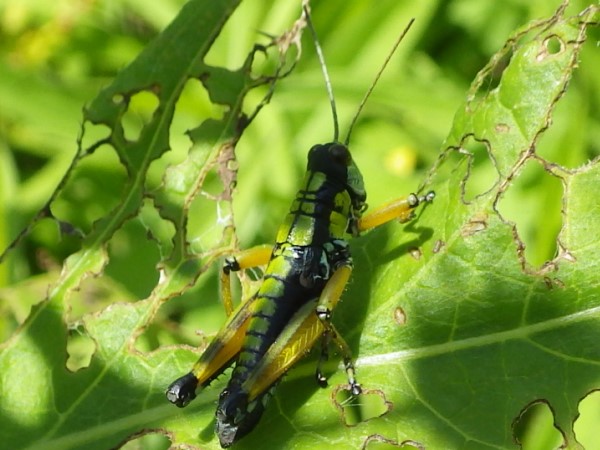 Podisma sapporensis sapporensis Shiraki 1910 (サッポロフキバッタ), short-horned grasshopper
Podisma sapporensis sapporensis Shiraki 1910 (サッポロフキバッタ), short-horned grasshopper
Subfam Oedipodinae (トノサマバッタ)Species and genera in HokkaidoLocusta (トノサマバッタ) L. migratoria L. 1758 (トノサマバッタ), migratory locust → locust mounds Mecostethus parapleurus (イナゴモドキ) Stethophyma magister (ツマグロバッタ) Aiolopus thalassinus (マダラバッタ) Epacromius japonicus (ヤマトマダラバッタ) Oedaleus infernalis (クルマバッタモドキ) Eusphingonotus japonicus (カワラバッタ) Arcypteridae Bolívar 1914Charilaidae Dirsh 1953= Pamphagodidae Bolívar 1884Chrotogonidae Bolívar 1884LathiceridaeLentulidaePamphagidae (フトスナバッタ)Pneumoridae (セミバッタ)Pyrgomorphidae (オンブバッタ)Superfam Eumastacoidea (クビナガバッタ)Eumastacidae (クビナガバッタ)Superfam Tetrigoidea (ヒシバッタ)BatrachididaeTetrigidae (ヒシバッタ)Superfam Tridactyloidea ノミバッタCylindrachetidae (ツツケラ), sandgropersubterranean apterous insectsthree genera: Cylindracheta (NT in Australia), Cylindraustralia (Tasmania and New Guinea) and Cylindroryctes (Argentina) RhipipterygidaeTridactylidae (ノミバッタ)Suborder Ensifera (剣弁, キリギリス)Superfam Grylloidea (コオロギ) |
Gryllidae (コオロギ, s.l.)= Myrmecophilidae (アリヅカコオロギ)
+ Mogoplistida (カネタタキ) Gryllus Laicharding 1781 (フタホシコオロギ) Gryllotalpidae (ケラ)Mogoplistidae (カネタタキ)Myrmecophilidae (アリヅカコオロギ)Superfam HagloideaProphalangopsidaeSuperfam Rhaphidophoroidea (カマドウマ)Rhaphidophoridae (カマドウマ)Superfam SchizodactyloideaSchizodactylidaeSuperfam Stenopelmatoidea (コロギス)AnostostomatidaeCooloolidaeGryllacrididae (コロギス)Stenopelmatidae (クロギリス)Superfam Tettigonioidea (キリギリス)Tettigoniidae Krauss 1902 (キリギリス)Gampsocleis Fieber 1852 (キリギリス): G. buergeri (キリギリス), Japanese katydid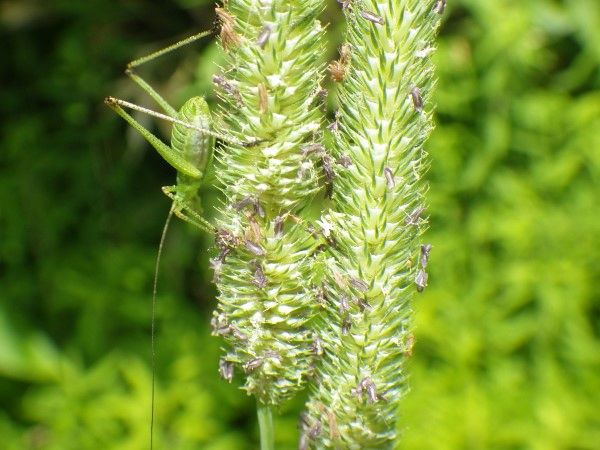
Subfam Phaneropterinae (ツユムシ)Subfam Pseudophyllinae (キョジンツユムシ)Subfam Mecopodinae Walker 1871 (クツワムシ)Mecopoda Serville 1831 (クツワムシ): M. nipponensis Haan (クツワムシ)Subfam Listroscelidinae (ウマオイ)Subfam Copiphorinae (クサキリ)Subfam Conocephalinae (ササキリ)Conocephalus melaenus Haan 1842 (ササキリ)Subfam Tettigoniinae (キリギリス) |
|
80000 species worldwide Characterized by sucking mouthparts. The followings are representative: Suborder Homoptera (同翅)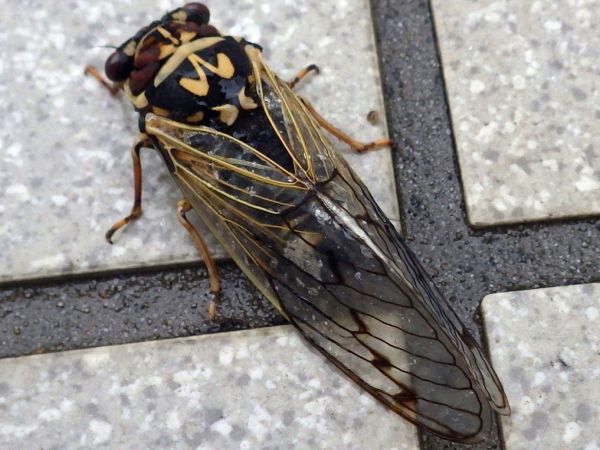 cicadas (セミ)
cicadas (セミ)planthoppers (ウンカ) Superfam Aphidoidea (アブラムシ) (*: extinct)Aphididae Latreille 1802 (アブラムシ), aphids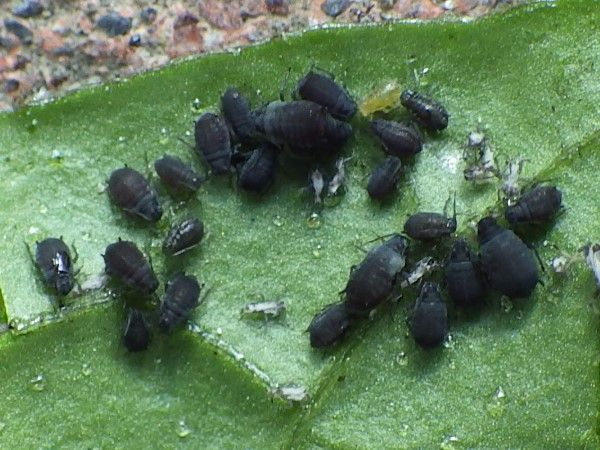 Aphis (ワタアブラムシ)
Aphis (ワタアブラムシ)A. fabae solanella Theobald 1914 (イヌホウズキクロアブラムシ), invasive species Indomegoura indica (キスゲフクレアブラムシ)  Macchiatiella (イタドリオマルアブラムシ)
Macchiatiella (イタドリオマルアブラムシ)Prociphilus (トドノネオオワタムシ) Uroleucon (セイタカアワダチソウヒゲナガアブラムシ): U. nigrotuberculatum (セイタカアワダチソウヒゲナガアブラムシ), U. gobonis (ゴボウヒゲナガアブラムシ), U. picridis (コウゾリナヒゲナガアブラムシ), U. sonchi (ノゲシヒゲナガアブラムシ), U. erigeronensis (ヒメムカシヨモギヒゲナガアブラムシ) Tetraneura (ヨスジワタアブラ): six species reported from Sapporo - T. nigriabdominalis (オカボノクロアブラムシ), T. sorini (オオヨスジワタムシ) and others  Uroleucon: U. gobonis (ゴボウヒゲナガアブラムシ)
Uroleucon: U. gobonis (ゴボウヒゲナガアブラムシ)
Adelgidae (カサアブラムシ)Phylloxeridae (ネアブラムシ)Bajsaphididae* Homan, Zyla et Wegierek 2015Canadaphididae* Richards 1966 |
Cretamyzidae* Heie 1992 Drepanochaitophoridae* Zhang et Hong 1999 Oviparosiphidae* Shaposhnikov 1979 Parvaverrucosidae* Poinar et Brown 2006 Sinaphididae* Zhang, Zhang, Hou et Ma 1989 + incertae cedis leafhoppers (ヨコバイ) Superfam Coccoidea (カイガラムシ) 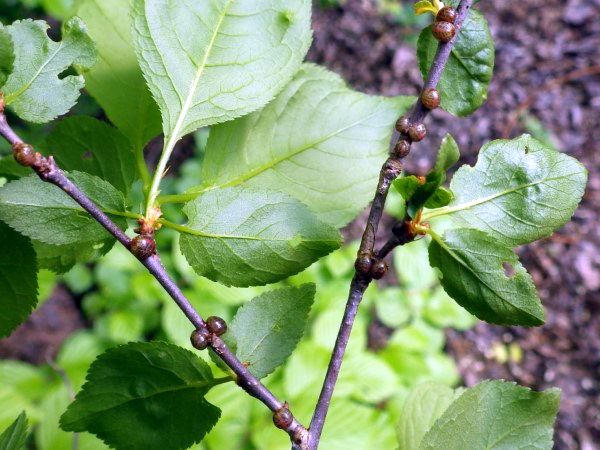 Orthezidae (ハカマカイガラムシ): Orthezia, Newsteadia, Nipponorthezia, Ortheziola, Ortheziolamameti
Orthezidae (ハカマカイガラムシ): Orthezia, Newsteadia, Nipponorthezia, Ortheziola, OrtheziolamametiMargarodidae (ワタフキカイガラムシ): Icerya Signoret 1875 Pseudococcidae (コナカイガラムシ) Coccidae (カタカイガラムシ) Diaspididae (マルカイガラムシ) Kermesidae (タマカイガラムシ). soft scales, wax scales or tortoise scales: Eulecanium Cockerell 1893 (タマカイガラムシ): E. kunoense Kuwana 1907 (タマカイガラムシ) Suborder Heteroptera (異翅)Infraorder Nepomorpha (タイコウチ)giant water bug (タガメ)water scorpion (タイコウチ) backswimmers (マツモムシ) Infraorder Cimicomorpha (トコジラミ/ナンキンムシ), bedbugSuperfam Miroidea (カスミカメムシ)Tingidae Laporte 1832 (グンバイムシ) Biologically-invasive species to Japan
Corythucha ciliata (Say) (プラタナスグンバイ) Infraorder Gerromorpha (アメンボ), water stridersInfraorder Pentatomomorpha (カメムシ), stink bugs or shield bugs |
Superfam Pentatomoidea Plataspidae (マルカメムシ) Cydnidae (ツチカメムシ) Scutelleridae (キンカメムシ) Pentatomidae (カメムシ) 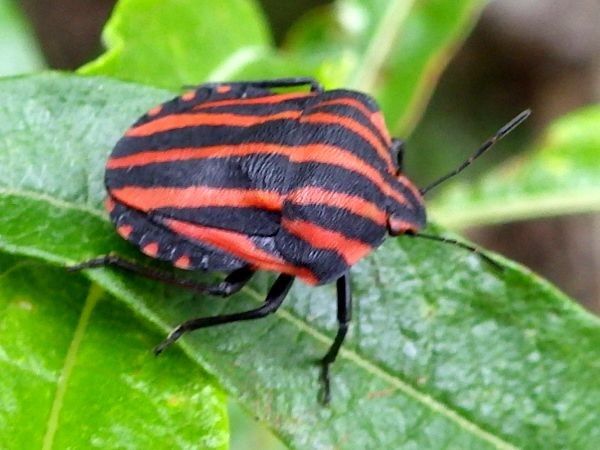 Graphosoma rubrolineatum (アカスジカメムシ)
Graphosoma rubrolineatum (アカスジカメムシ)Palomena angulosa (Motschulski) (エゾアオカメムシ) Nezara Amyot et Serville 1843 (アオカメ): N. antennata Scott (アオクサカメムシ), N. viridula Linnaeus (ミナミアオカメムシ) Acanthosomatidae (ツノカメムシ) Urostylididae (クヌギカメムシ) Superfam Coreoidea (ヘリカメムシ) Coreidae (ヘリカメムシ) 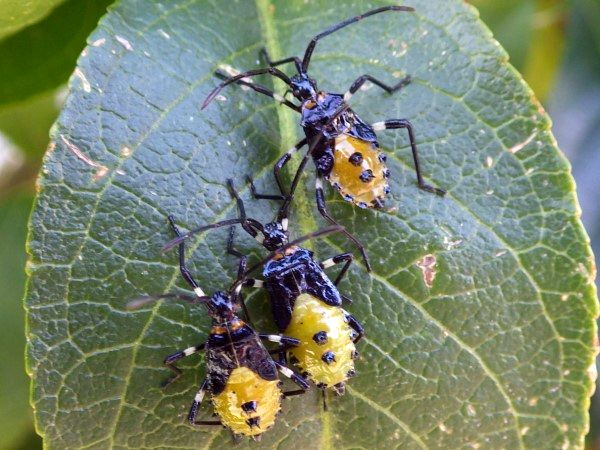
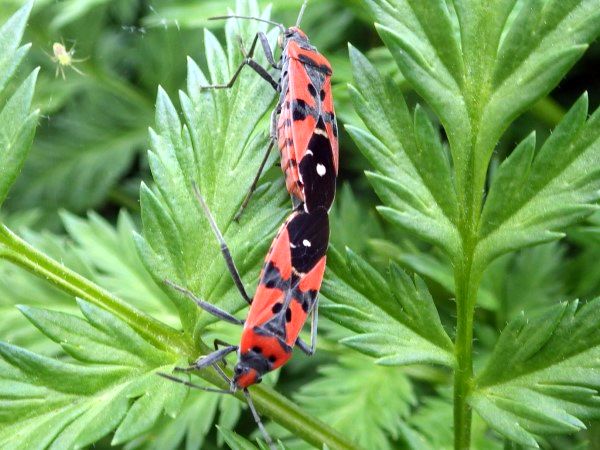
Superfam Lygaeoidea (ナガカメムシ) Lygaeidae (ナガカメムシ) Lygaeus equestris (マダラナガカメムシ), black-and-red-bug, May-September, Hokkaido and northern Honshu, 10-13 mm long L.e. equestris equestris (Linnaeus 1758), L.e. equestris sicilianus (Wagner 1955) 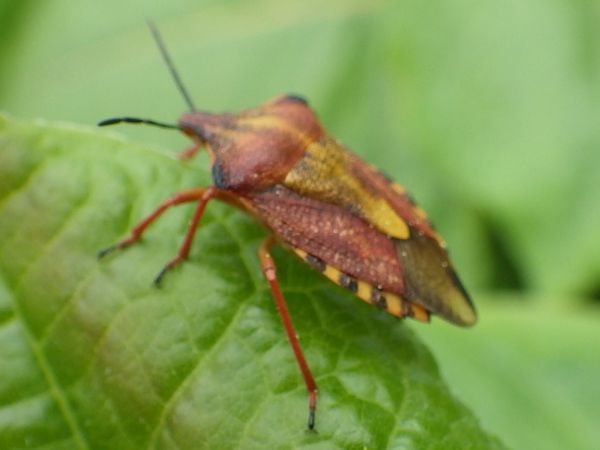 Carpocoris purpureipennis (ムラサキカメムシ)
Carpocoris purpureipennis (ムラサキカメムシ)Berytidae (イトカメムシ) Malcidae (メダカナガカメムシ) Largidae (オオホシカメムシ) Pyrrhocoridae (ホシカメムシ) Superfam Aradoidea (ヒラタカメムシ) Aradidae (ヒラタカメムシ) |
|
after Permian Complete metamorphosis Suborder Archostemata ナガヒラタムシ(始原)Superfam Cupedoidea ナガヒラタムシCupedidae ナガヒラタムシMicromalthidae チビナガヒラタムシ Suborder Adephaga オサムシ(食肉)Superfam Caraboidea オサムシ carabidsRhysodidae セスジムシCicindelidae ハンミョウ 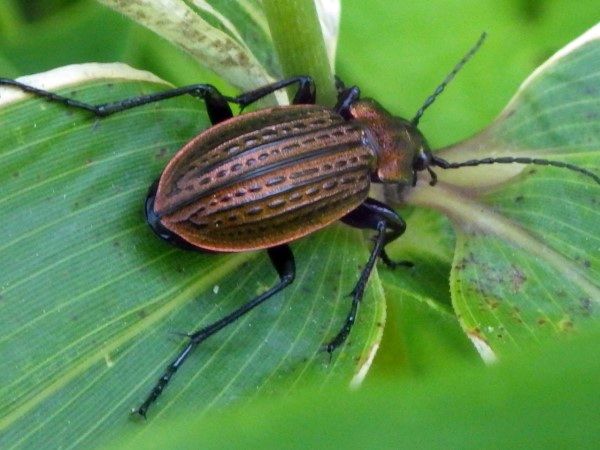 Carabidae オサムシ carabids
Carabidae オサムシ carabidsHemicarabus maeander paludis Fischer 1822 (セスジアカガネオサムシ) Damaster blaptoides Kollar 1836 (マイマイカブリ), Japanese ground beetle 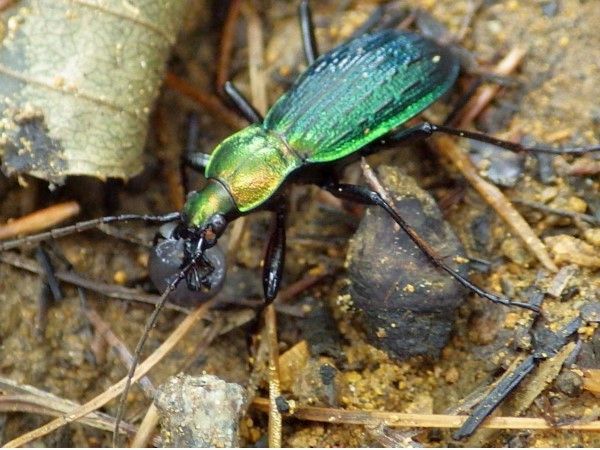
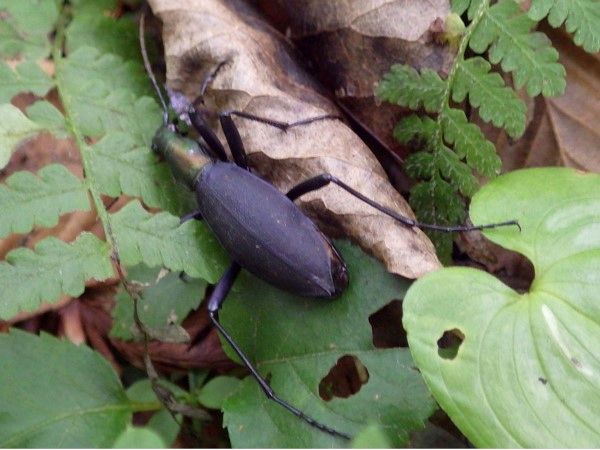 rugipennis Motschulsky 1861 (エゾマイマイカブリ), Hokkaido viridipennis Lewis 1880 (キタマイマイカブリ), northern Tohokku babaianus Ishikawa 1984 (コアオマイマイカブリ), Sendai fortunei Adamus 1861 (アオマイマイカブリ), Awajima Isl oxuroides Schaum 1862 (ヒメマイマイカブリ), Isu-Oshima, Kanto and Chubu capito Lewis 1880 (サドマイマイカブリ), Sado Isl. brevicaudus Imura et Mizusawa 1995 (オキマイマイカブリ), Oki Isl. blaptoides Kollar 1836 (マイマイカブリ), western Japan Paussidae ヒゲブトオサムシ Scaritidae ヒョウタンゴミムシ Harpalidae ゴミムシ ground beetle Brachinidae ホソクビゴミムシ Paussidae カワラゴミムシ Halipliplidae コガシラミズムシ Noteridae コツブゲンゴロウ Dytiscidae ゲンゴロウdiving beetle Gyrinidae ミズスマシ whirligig beetle Suborder Myxophagaツブミズムシ(粘食)Superfaimily Microsporioidea ツブミズムシTorridincolidae ツブミズムシSuborder Polyphaga カブトムシ(多食)Superfam Hydrophiloidea ガムシHydrophilidae ガムシ: ガムシ、コガムシHydrochidae ホソガムシ Helophoridae セスジガムシ Georissidae マルドロムシ Superfam Histeroidea エンマムシHisteridae エンマムシSynteliidae エンマムシモドキ Sphaeritidae エンマムシダマシ Superfam Staphylinoidea ハネカクシ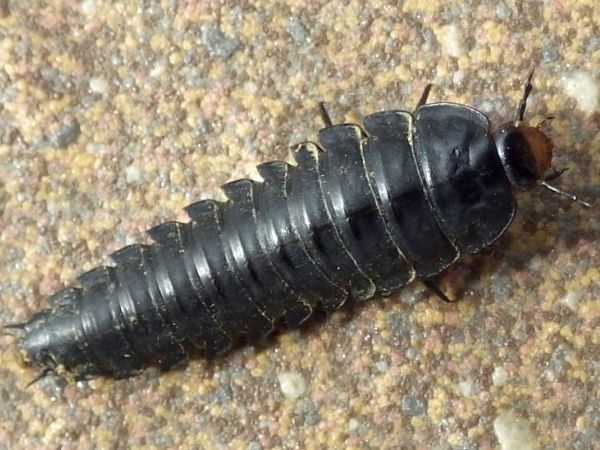 Silphidae シデムシcarrion beetle
Silphidae シデムシcarrion beetlemost species are scavengers Nicrophorus (N. concolor Kraatz 1877), Silpha (S. paerforata: Hokkaido)  Staphylinidae ハネカクシ rove beetle
Staphylinidae ハネカクシ rove beetleEusphalerum parallelum Sharp 1889 × Paederus littoralis Gravenhorst 1802: The body fluid causes dermatitis and/or loss of eyesight. × Scydmaenidae コケムシ Leiodidae タマキノコムシ Ptiliidae ムクゲキノコムシ Hydraenidae ダルマガムシ Superfam Scarabaeoidea コガネムシLucanidae クワガタムシ stag beetleDorcus hopei binodulosus Waterhouse 1874 (オオクワガタ), RDB = VU Dorcus montivagus Lewis ヒメオオクワガタ, alpine Dorcus (Macrodorcus) rectus Motschulsky 1857 コクワガタ Prosopocoilus inclinatus Motschulsky 1857 ノコギリクワガタ many other species Diphyllostomatidae ホソマグソクワガタ Geotrupidae センチコガネ Trogidae コブスジコガネ 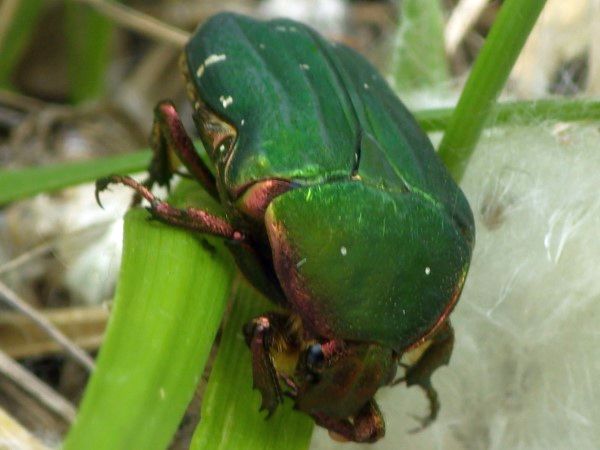 Scarabaeidae コガネムシ: ≈ 30000 species between subarctic and tropical regions
Scarabaeidae コガネムシ: ≈ 30000 species between subarctic and tropical regionsEucetoma roelofsi アオハナムグリ |
Passalidae クロツヤムシ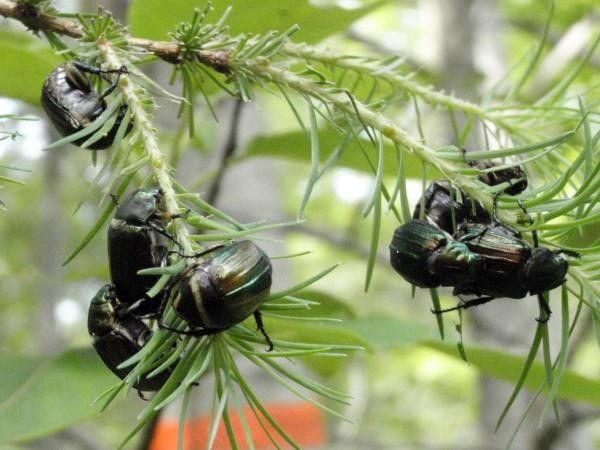 Anomala testaceipes Motshulsky スジコガネ
Anomala testaceipes Motshulsky スジコガネ
Color: diverse Superfam Byrrhoidea マルトゲムシByrrhoidae マルトゲムシSuperfam Buprestoidea タマムシLeiodidae タマムシjewel beetleSuperfam Elateroidea コメツキムシElateridae コメツキムシ click beetle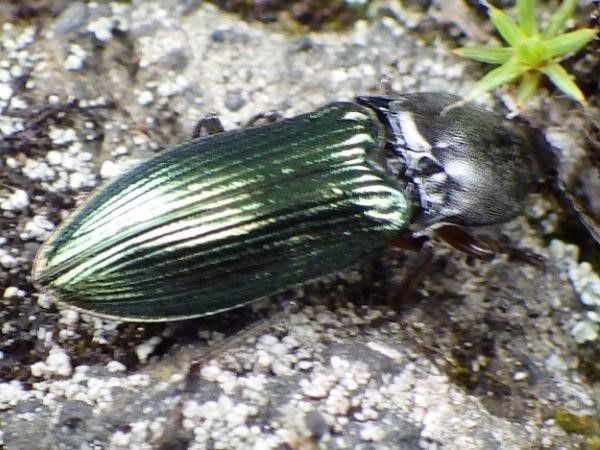
Superfam Dryopoidea ドロムシDryopidae ドロムシElminthidae ヒメドロムシ Heteroceridae ナガドロムシ Psephenidae ヒラタドロムシ Callirhipidae ホソクシヒゲムシ Chelonariidae ダエンマルトゲムシ Ptilodactylidae ナガハナノミ Superfam Cantharoidea ホタルBrachypsectridae ブラキプセクトラ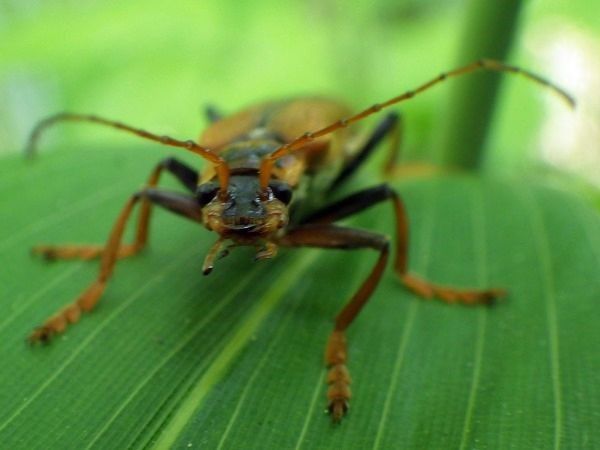
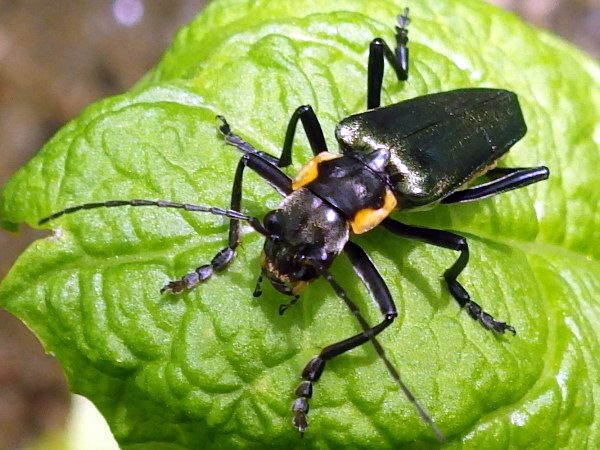 Cantharidae ジョウカイボン (soldier beetle): Athemus suturellus (ジョウカイボン), Themus cyanipennis (アオジョウカイ) Cneoglossidae クネオグロスス Drilidae ドリルス Homalisidae ホマリスス Lampyridae Latreille 1817 (ホタル), firefly Luciola Laporte 1833 (ホタル)
L. cruciata Motschulsky 1854 (ゲンジボタル): 12-18 mm l 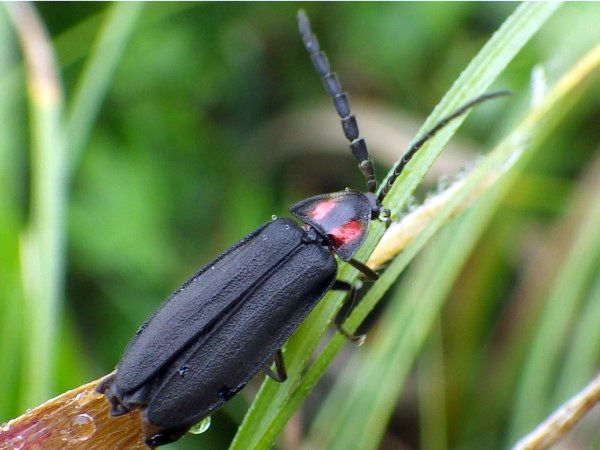 Lucidina (オバボタル): L. biplagiata Motschulsky 1866
Lucidina (オバボタル): L. biplagiata Motschulsky 1866Lycidae (ベニボタル), net-winged beetle Lycostomus Motschulsky 1861: L. modestus Motschulsky 1854 (ベニボタル) 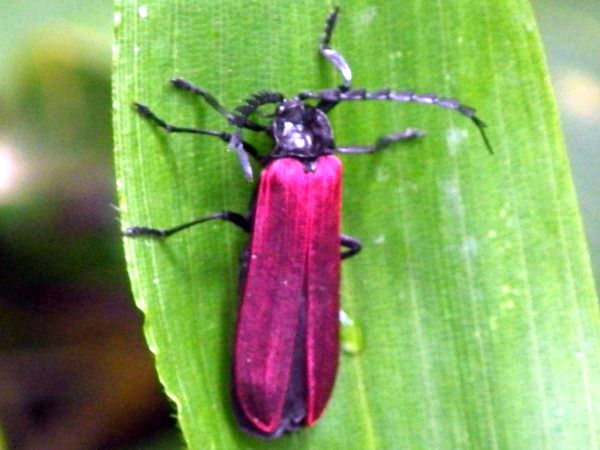 Omethidae ホタルモドキ
Omethidae ホタルモドキTelegeusidae テレゲウシス Superfam Dermestoidea カツオブシムシDermestidae カツオブシムシ carpet beetleDerodontidae マキムシモドキ Nosodendridae ヒメトゲムシ Superfam Bostrychoidea ナガシンクイBostrychidae ナガシンクイAnobiidae シバンムシ: シバンムシ Ptinidae ヒョウホンムシ Superfam Lymexyloidea ツツシンクイLymexylonidae ツツシンクイSuperfam Cleroidea カッコウムシTrogossitidae コクヌストCleridae カッコウムシ Melyridae ジョウカイモドキ Superfam Cucujoidea ヒラタムシCryptophagidae キスイムシHelotidae オオキスイムシ Rhizophagidae ネスイムシ Nitidulidae ケシキスイムシ Propalticidae ミジンキスイムシ Biphyllidae ムクゲキスイムシ Byturidae キスイモドキ Cucujidae ヒラタムシ Erotylidae オオキノコムシ Sphindidae ヒメキノコムシ Languriidae コメツキモドキ Phalacridae ヒメハナムシ Cerylonidae カクホソカタムシ Corylophidae ミジンムシ Discolomidae ミジンムシダマシ Coccinellidae テントウムシ lady beetle Coccinella septempunctata Linnaeus 1758 ナナホシテントウ |
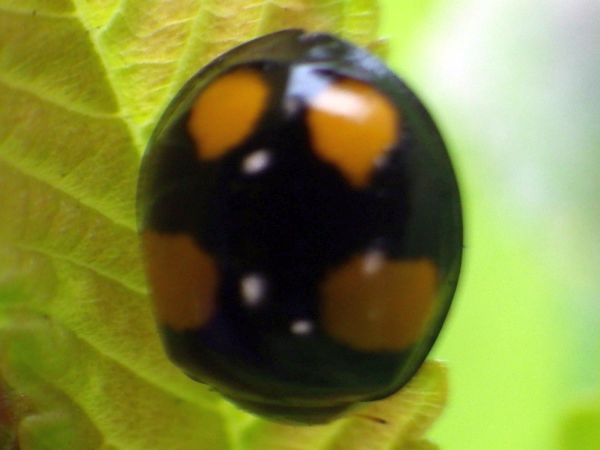
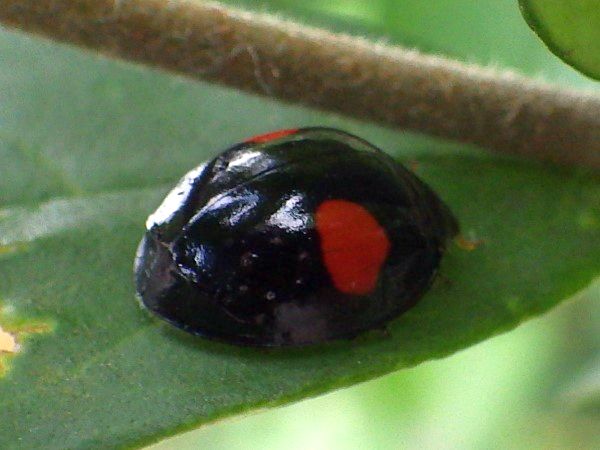
Harmonia axyridis Pallas 1773 ナミテントウ, diverse mottles Henosepilachna: H. vigintioctopunctata Fabricius 1775 ニジュウヤホシテントウ, H. vigintioctomaculata オオニジュウヤホシテントウ 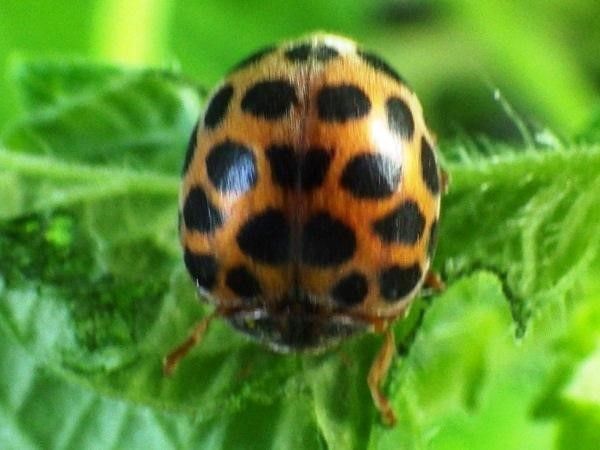 Endomychidae テントウダマシ
Endomychidae テントウダマシ
Superfam Tenebrionoidea ゴミムシダマシTenebrionidae ゴミムシダマシLagriidae ハムシダマシ Cephaloidae クビナガムシ Meloidae ツチハンミョウ Oedemeridae カミキリモドキ Synchroidae ヒラタナガクチキ Mycteridae ホソキカワムシ Boridae ツヤキカワムシ Salpingidae チビキカワムシ Pyrochroidae アカハネムシ Anthicidae アリモドキ Euglenidae ニセクビホソムシ Scraptiidae ハナノミダマシ Superfam Chrysomeloidea ハムシ= leaf beetle Cerambycidae カミキリムシ, longhorn beetle
Cerambycidae カミキリムシ, longhorn beetleSubfam Cerambycinae Latreille 1802 (カミキリ) Neocerambyx radde (Massicus raddei) ミヤマカミキリ, Aeolesthes chrysothrix (キマダラミヤマカミキリ), Kurarua rhopalophoroides (クビアカモモブトホソカミキリ), Rosalia batesi (ルリボシカミキリ), Purpuricenus temminckii (ベニカミキリ), Chloridolum japonicum (アカアシオオアオカミキリ), Chloridolum viride (ミドリカミキリ), Callidiellum rufipenne (ヒメスギカミキリ), Xylotrechus Chevrolat 1860: X. rufilius (クビアカトラカミキリ), X. cuneipennis (ウスイロトラカミキリ), X. undulatus Say 1824 (taken in Alaska), Cyrtoclytus caproides (キスジトラカミキリ), Kazuoclytus lautoides (ヤマトシロオビトラカミキリ) Subfam Disteniinae (ホソカミキリ) Subfam Lamiinae (フトカミキリ) Anoplophora malasiaca Thomson 1865 (ゴマダラカミキリ) 
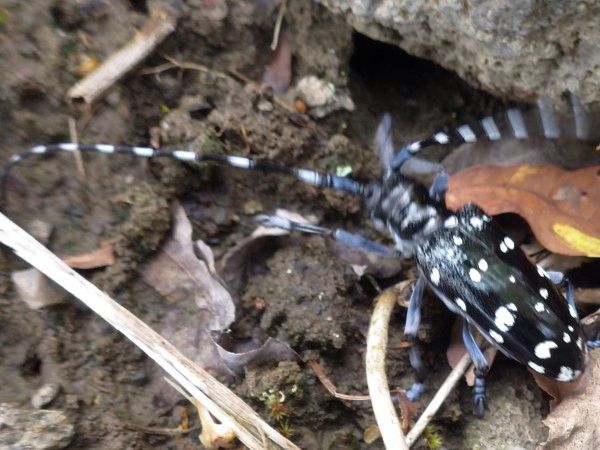 Subfam Lepturinae (ハナカミキリ) Subfam Necydalinae (ホソバコバネカミキリ) Subfam Parandrinae (ニセクワガタカミキリ) Subfam Prioninae (ノコギリカミキリ) Bruchidae (マメゾウムシ) Callosobruchus chinensis L. (アズキゾウムシ) Chrysomelidae ハムシ, leaf beetle Subfam Chrysomelinae Latreille 1802 (ハムシ) Linaeidea aenea aenea Linnaeus 1758 (ルリハムシ) Chrysomela populi L. 1758 (ドロノキハムシ) Chrysolina aurichalcea Mannerheim 1825 (ヨモギハムシ) 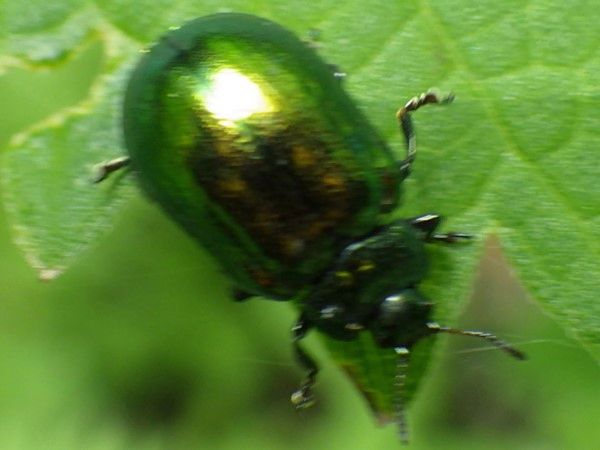


Superfam Curculionoidea ゾウムシAnthribidae ヒゲナガゾウムシApionidae ホソクチゾウムシ Attelabidae オトシブミ Brenthidae ミツギリゾウムシ Curculionidae ゾウムシ billbug, elephant beetle Rhynchophoridae オサゾウムシ Scolytidae キクイムシ bark beetle Platypodidae ナガキクイムシ Superfam Scirtoidea マルハナノミHelodidae マルハナノミEucinetidae マルハナノミダマシ Clambidae タマキノコムシモドキ Superfam Artematopodoidea ナガハナノミダマシArtematopodoidae ナガハナムシダマシSuperfam Dascilloidea ナガフナガタムシRhipiceridae クシヒゲムシ |
= butterflies + mothsSuborder AglossataSuperfam AgathiphagoideaAgathiphagidaeSuborder Zeugloptera コバネガSuperfam Micropterigoidea コバネガMicropterigidae コバネガSuborder HeterobathmiinaSuperfam HeterobathmioideaHeterobathmiidaeSuborder GlossataSuperfam Papilionoidea アゲハチョウPapilionidae アゲハチョウ, swallowtail butterflySubfam Baroniinae ウラギンアゲハ(メキシコアゲハ)Subfam Parnassiinae ウスバアゲハ(ウスバシロチョウ) Subfam Papilioninae アゲハチョウ Pieridae シロチョウ, white butterflySubfam Pseudopontiinae マルバネシロチョウSubfam Dismorphiinae コバネシロチョウ(トンボシロチョウ) Subfam Coliadinae モンキチョウ Colias Fabricius 1807 モンキチョウ (C. erate Esper 1805, モンキチョウ eastern pale clouded 6ellow - poliographus Motschulsky 1860, subspecies in Japan) 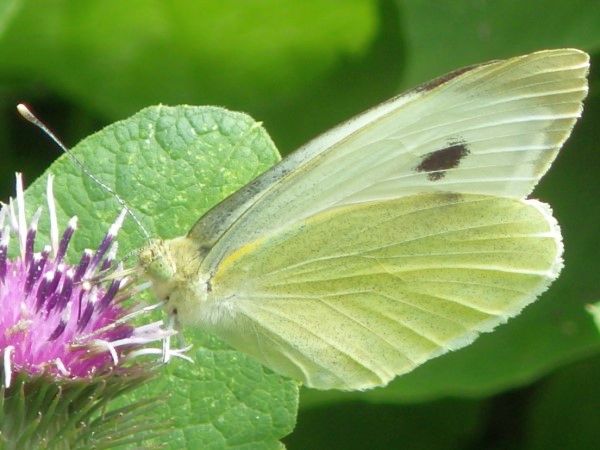 Subfam Pierinae シロチョウ
Subfam Pierinae シロチョウAporia ミヤマシロチョウ, Anthocharis ツマキチョウ, Delias カザリシロチョウ, Hebomoia ツマベニチョウ, Pereute ベニオビシロチョウ, Pieris モンシロチョウ (P. rapae L. 1758 = small cabbage white モンシロチョウ, P. brassicae L. 1758 = large cabbage white オオモンシロチョウ) 
Lycaenidae シジミチョウ, gossamer-winged butterflies5200 spp worldwide - all regions except AntarcticaSubfam Lycaeninae ベニシジミ, copper Tribe Heliophorini Heliophorus, sapphires Iophanus Melanolycaena Tribe Lycaenini Athamanthia Gaeides, included into Lycaena Hyrcanana 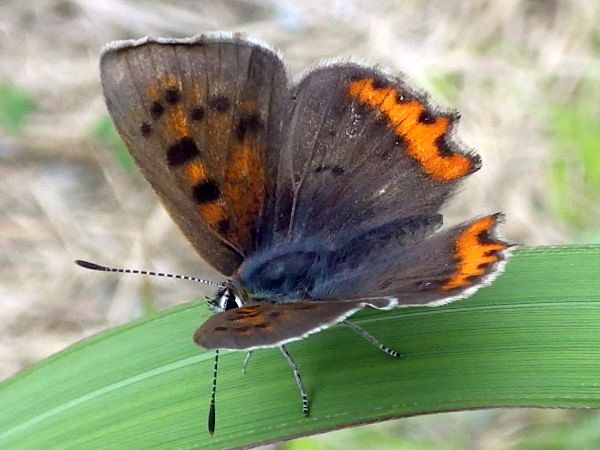 Lycaena Fabricius 1807 (ベニシジミ), typical coppers
Lycaena Fabricius 1807 (ベニシジミ), typical coppersOne in Japan = L. phlaeas chinensis Felder 1862 (ベニシジミ) Phoenicurusia |
Subfam Polymmatinae ヒメシジミ Zizeeria maha Kollar 1844 (ヤマトシジミ, pale grass blue), seasonal changes in the wing color and design, south to Honshu Subfam Lyphyrinae アリノスシジミ Subfam Miletinae アシナガシジミ(カニアシシジミ) Subfam Poritiinae ホウセキシジミ(キララシジミ) Subfam Theclinae ミドリシジミ Subfam Lipteninae コケシジミ Subfam Curetinae ウラギンシジミ Riodinidae シジミタテハSubfam StyginaeSubfam Hamearrinae Subfam Euselasiinae ベニモンシジミタテハ Subfam Corrachiinae Subfam Riodininae シジミタテハ Nymphalidae タテハチョウ, brush-footed butterfliesSubfam Charaxinae フタオチョウ: Polyura eudamippus weismanni フタオチョウSubfam Marpesiinae イシガケチョウ: Cyrestis thyodamas kumamotensis イシガケチョウ Subfam Apaturinae コムラサキ: Apatura metis substituta コムラサキ, Sasakia charonda charonda オオムラサキ Subfam Biblinae カバタテハ: Ariadne ariadne pallodoor カバタテハ Subfam Argynninae ヒョウモンチョウ Subfam Pseudoeigrolinae ヒョウモンモドキ(スミナガシ)(sometimes treated as family): Melitaea regama ウスイロヒョウモンモドキ Subfam Limenitinae イチモンジチョウ Subfam Nymphalinae タテハチョウ(ヒオドシチョウ): Hypolimnas bolina L. リュウキュウムラサキ, Inachis io geisha L. クジャクチョウ 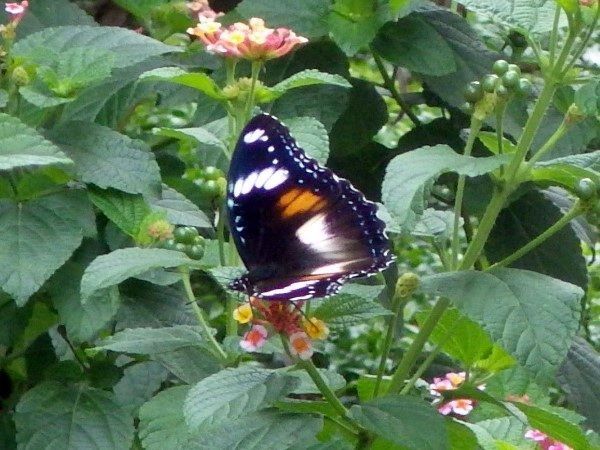
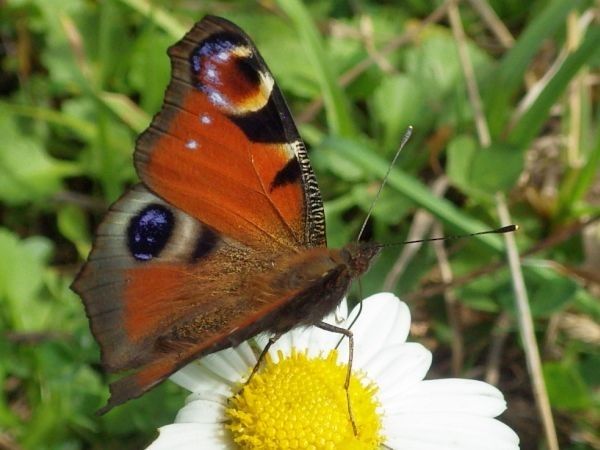 (Subfam Heliconiinae ドクチョウ, Subfam Acraeinae ホソチョウ, Subfam Calinaginae クビワチョウ: hitherto-known taxa)
(Subfam Heliconiinae ドクチョウ, Subfam Acraeinae ホソチョウ, Subfam Calinaginae クビワチョウ: hitherto-known taxa)
Satyridae ジャノメチョウSubfam Satyrinae ジャノメチョウSubfam Amathusiinae ワモンチョウ Subfam Morphinae モルフォチョウ Subfam Brassolinae フクロウチョウ Danaidae マダラチョウSubfam Danainae マダラチョウSubfam Ithomiinae トンボマダラ Superfam Hesperioidea セセリ(チョウ)Hesperiidae セセリチョウSubfam Coeliadinae アオバセセリSubfam Megathyminae イトランセセリ Subfam Pyrrhopyginae ピロピゲ Subfam Pyrginae チャマダラセセリ Subfam Heteropterinae チョウセンキボシセセリ Subfam Trapezitinae トラペジテス Subfam Hesperiinae セセリチョウ |
Suborder Glossata 有吻Superfam Sesioidea スカシバガSesiidae スカシバガno scales → clear-winged mothsSynanthedon scoliaeformis japonica Špatenka et Arita, 1992 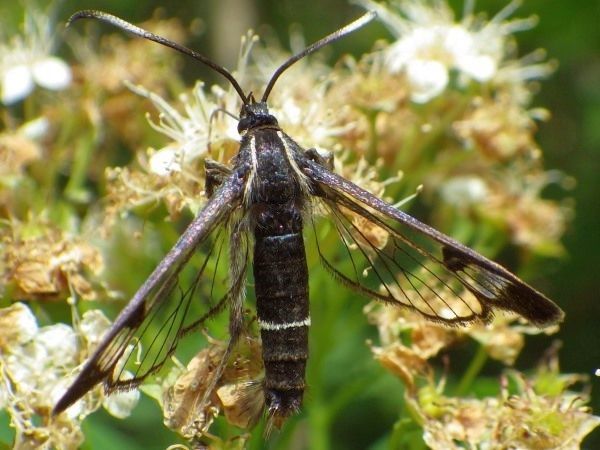
Superfam Hedyloidea シャクガモドキHedylidae シャクガモドキOne genus that is Macrosoma シャクガモドキSuperfam Zygaenoidea Latreille 1809 マダラガZygaenidae マダラガBalataea gracilis gracilis Walker 1865 キスジホソマダラSuperfam Bombycoidea カイコガBombycidae カイコガBombyx mori Linnaeus 1758 (カイコガ), silk moth or silkwormSphingidae スズメガSubfam Smerinthinae ウチスズメ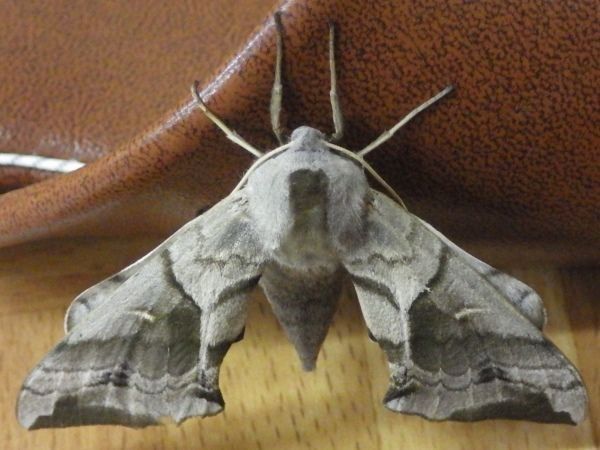 Callambulyx (C. tatarinovii gabyae Bryk 1946 ウンモンスズメ), Marumba (M. gaschkewitschii echephron Boisduval 1875 モモスズメ), Phyllosphingia, Smerinthus Latreille 1802 (S. planus planus Walker 1856 ウチスズメ)
Callambulyx (C. tatarinovii gabyae Bryk 1946 ウンモンスズメ), Marumba (M. gaschkewitschii echephron Boisduval 1875 モモスズメ), Phyllosphingia, Smerinthus Latreille 1802 (S. planus planus Walker 1856 ウチスズメ) Meganoton Boisduval 1875 (M. analis scribae Austaut 1911 エゾシモフリスズメ)
Meganoton Boisduval 1875 (M. analis scribae Austaut 1911 エゾシモフリスズメ)Erebidae ヤガ, owlet moths Stinging moth (ドクガ)Some larvae have poisonous bristles, which induce dermatitis with (severe) pain, itchiness and/or swelling when touched. Wash your skin with tap water without scratching.Euproctis subflava Bremer (ドクガ): larva/imago - toxic E. pseudoconspersa Strand 1914 (チャドクガ): imago - toxic, not distributed in Hokkaido Dendrolimus spectabilis Butler (マツカレハ): larva - toxic Cnidocampa flavescens (Walker) (イラガ): larva - toxic Artona funeralis Butler (タケノホソクロバ): larva - toxic 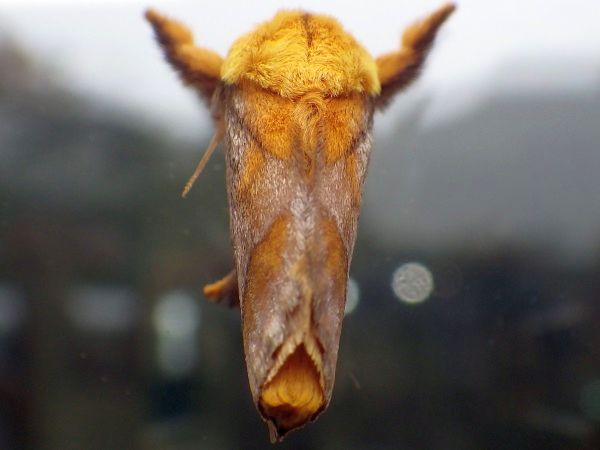
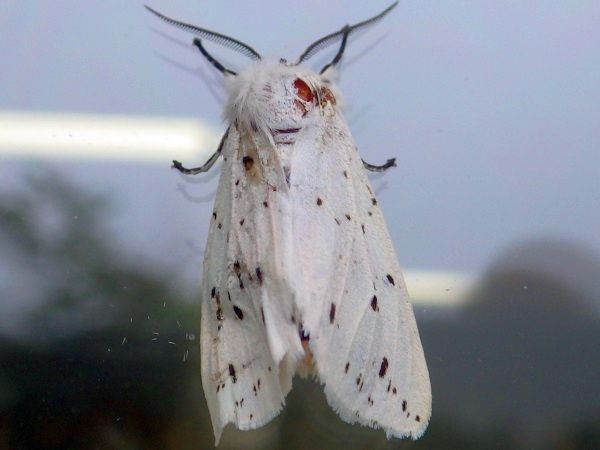

|
 after Jurassic
after JurassicSuborder Symphyta 広腰亜目Superfam Xyeloidea ナギナタハバチSuperfam Megalodontoidea ヒラタハバチSuperfam Siricoidea キバチSuperfam Orussoidea ヤドリキバチSuperfam Cephoidea クキバチSuperfam Tenthredinoidea ハバチCimbicidae W Kirby 1837 (コンボウハバチ)130 species in 6 or 20 genera in the world Abia Leach 1817 (コンボウハバチ): A. akebiae (Takeuchi 1931) (アケビコンボウハバチ) China - south to Honshu, A. metallica Mocsary 1909 (ネジロコンボウハバチ) China - eastern Siberia - Japan, A. triangularis (Takeuchi 1931) (フトオビコンボウハバチ) south to Honshu Orientabia Malaise 1934 (ルリコンボウハバチ): O. iridescens (Marlatt 1898) (アカガネコンボウハバチ) south to Honshu, O. japonica (Cameron 1887) (ルリコンボウハバチ), Siberia - Japan Agenocimbex Rohwer 1910 (ホシアシブトハバチ): A. maculatus (Marlatt 1898) (ホシアシブトハバチ), south to Honshu |
Leptocimbex Semenov 1896 (ヨウロウヒラクチハバチ): L. malaisei Takeuchi 1939 (マライセヒラクチハバチ) Honshu and Shikoku, L. yorofui (Marlatt 1898) (ヨウロウヒラクチハバチ), south to Honshu Praia Wankowicz 1880 (シマコンボウハバチ): P. ussuriensis Malaise 1939 (シマコンボウハバチ), eastern Siberia - Japan Suborder Apocrita 細腰亜目Terebrantia 有錐類Superfam Trigonaloidea カギガラバチSuperfam Ichneumonoidea ヒメバチSuperfam Evanoidea ヤセバチSuperfam Cynipoidea タマバチSuperfam Chalcidoidea コバチSuperfam Proctotrupoidea シリボソクロバチAculeata 有剣類Superfam Bethyloidea アリガタバチSuperfam Scolioidea ツチバチSuperfam Formicoidea アリ262 species in 62 genera in JapanFormicidae Latreille 1809, ant Camponotus Mayr 1861, carpenter ant: C. obscuripes Mayr 1878 (ムネアカオオアリ) Lasius japonicus Santschi 1941 (トビイロケアリ), formerly L. niger L. 1758, black garden ant Polyergus Latreille 1804 (サムライアリ): obligatory slave-makers Formica L. 1758 (アカヤマアリ), wood ants, mound ants, thatching ants, and field ants |
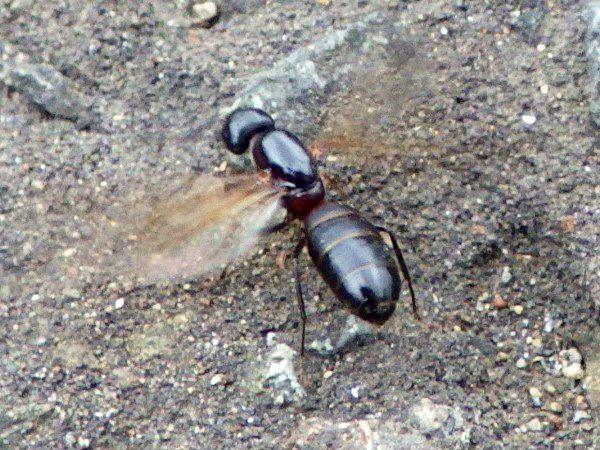
 Superfam Pompiloidea (ベッコウバチ)Batozonellus annulatus Fabricius (キオビクモバチ)Superfam Vespoidea (スズメバチ)Vespidae (スズメバチ)Polistinae (アシナガバチ), hunting wasps or paper wasps Tribe Polistini (アシナガバチ): Polistes (アシナガバチ) only (200 species) Tribe Ropalidini (チビアシナガバチ): 4 genera, Ropalidia (チビアシナガバチ), Parapolybia (ホソアシナガバチ) Tribe Mischocyttarini (ヒメアシナガバチ): Mischocyttarus onlys Tribe Epiponini (エピポナ): 17 genera The two tribes shown above are distributed in the tropical and temperate regions of the North and South America Vespinae (スズメバチ) Vespa mandarinia Smith (オオスズメバチ) Eumeninae ドロバチ* Stenogastrinae ハラホソバチ Masarinae (ハナドロバチ) Euparagiinae サバクドロバチ Superfam Sphecoidea (アナバチ)Superfam Apoidea (ハナバチ) |
|
two-winged flies,or true flies > 100000 species, after Jurassic  Larvae: culiciform head capsule present with chewing mouthparts legs absent vermiform (maggots) without legs or a distinct head capsule mouthparts reduced; only present as mouth hooks Adult: antennae filiform, stylate or aristage mouthparts suctorial (haustellate) mesothrax larger than pro-or metathorax one pair of wings (front); hind wings reduced (halteres) tarsi five-segmented Suborder Nematocera 長角 (Orthorrhapha 直縫)Culicidae カ(蚊) |
3146 spp in the world (Zavortink, 1990), [Culex, Aedes, Anopheles] = mosquito-complex Subfam Toxorhynchitinae オオカ Subfam Culicinae ナミカ Culicini ナミカ族: Japan – Culex イエカ (C. pipiens pallens Coquillett アカイエカ, C. pipiens molestus Forskal チカイエカ), Aedesヤブカ (A. albopictus (Skuse) ヒトスジシマカ) Sabethini ナガハシカ族 Subfam Anophelinae ハマダラカ About 50 morpho-species – number of sibling species is more than that of morpho-species Anopheles ハマダラカ, Bironella, Chagasis Ceratopogonidae (punkie) (ヌカカ)We hate punkie more than mosquito when we survey in Hokkaido.Simuliidae (gnat or blackfly) (ブヨ)Female only sucks blood. Severe itchness remain on the skin for a long period after bitten.Cecidomyiidae (gall midges or gall gnats) (タマバエ)Body length: 1-3 mm longAntenna: long Wing: covered with hair Larva: mostly ectoparasitism by utilizing insect or plant (developing insect gall) a gall developed on Senecio cannabifolius Subfam CecidomyiinaeSubfam Lestremiinae Subfam Porricondylinae |
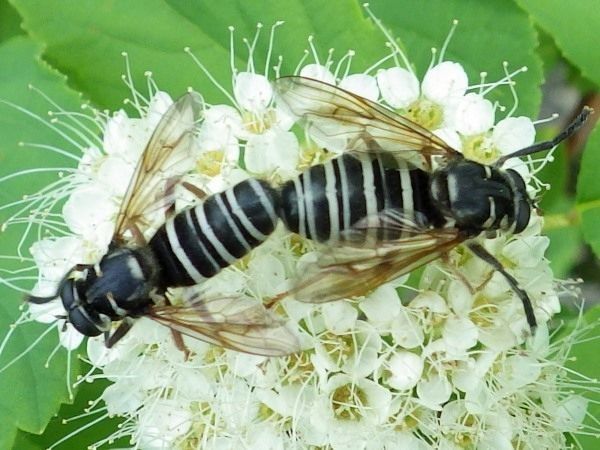
Suborder Brachycera 短角Tabanidae (アブ)Tabanus アブ gadfly or horse fly× Severe pain may occur after stung. Watch out when you are in meadows and farms, because gadfly clings to cow and horse. Stop sucking blood from a wound. I have ever felt nauseating without bottle-ache, because of sensitiveness. × 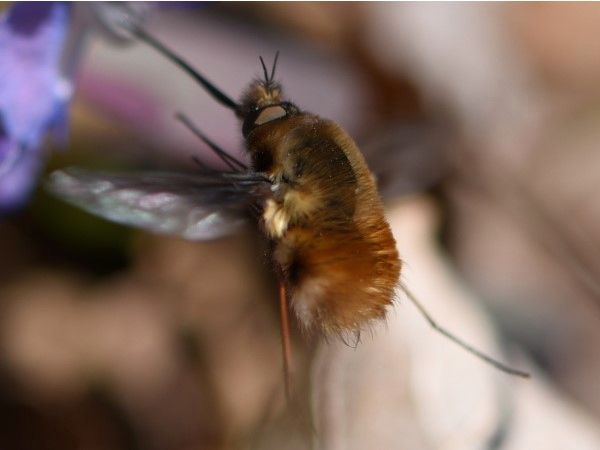
Bombyliidae (ツリアブ, bee fly)トラツリアブ Anastoechus nitidulus Fabricius 1794 (トラツリアブ), Bombylius major L. 1858 (ビロウドツリアブ)Syrphidae Latreille 1802 (ハナアブ, hoverfly)Subfam Syrphinae (ヒラタアブ)Subfam Milesiinae (ナミハナアブ) Phytomia zonata (オオハナアブ) Subfam Microdontinae (アリノスアブ) Suborder Cyclorrhapha 環縫Drosophila ショウジョウバエ fruit flyD. virilis (クロショウジョウバエ), D. melanogaster (キイロショウジョウバエ), D. immigrans (オオショウジョウバエ) Calliphora クロバエ, ニクバエ |
|
= water insects living some portion of their life cycle in the water Aquatic adaptation
*: four major taxa Orders with aquatic or semiaquatic insectsCollembola (springtails)Ephemeroptera* (mayflies) Odonata (dragonflies and damselflies) Plecoptera* (stoneflies) Megaloptera (alderflies, fishflies and dobsonflies) Neuroptera (lacewings) Coleoptera (beetles) Hemiptera (true bugs - water striders, giant water bugs) Hymenoptera (ants and wasps Diptera* (flies and mosquitoes) Mecoptera (scorpionflies) Lepidoptera (moths) Trichoptera* (caddisflies) |
ID keys in the aquatic larval stage[with legs] → no → Diptera__↓ yes__________________________(two tails) [worm-like]________→ no → [three tails] → no → [two claws] [without wing pads]____________↓ yes_______↙ no___↓ yes [without long tails]____________Ephemeroptera___Plecoptera __(with cases) __↓ yes Trichoptera ID keys in the adult stage[two pair of wings] → no (1 pair) → Diptera__↓ yes [hairy wings]_________→ no → [transparent wings]_______→ no → P [tent-like folded wings]________ [much smaller hind wings] __(no tails)___________________(apparent tails) __↓ yes______________________↓ yes Trichoptera_______________Ephemeropteera
Plecoptera |
[safety manual memorandum, field equipment, poisonous plant]
|
Vermin in field work: nocent insects that decline the effectivness of work Nocent insects that are directly and/or indirectly affect human health ☛ bee/wasp, gadfly, gnat or blackfly, mosquito, moth, punkie, rove beetle, tick (non-insect) Locust Mounds at Teine-Yamaguchi- Designated historic site of Sapporo -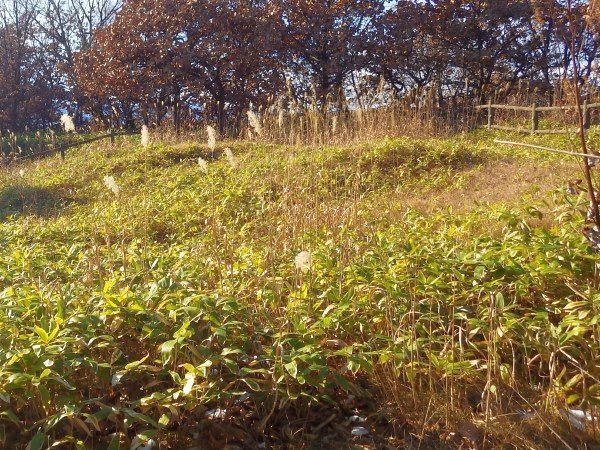 The Ainu have passed down stories of "swarming of locusts" breaking out every few decades in Hokkaido, even before agriculture spread all over the island. The largest outbreak never recorded occurred in 1980 in the Tokachi district and spread to the Hidaka, Iburi, Shiribeshi, and Oshima districts, causing tremendous damage to agricultural crops through 1885.
The Ainu have passed down stories of "swarming of locusts" breaking out every few decades in Hokkaido, even before agriculture spread all over the island. The largest outbreak never recorded occurred in 1980 in the Tokachi district and spread to the Hidaka, Iburi, Shiribeshi, and Oshima districts, causing tremendous damage to agricultural crops through 1885.These swarms consisted of Locusta migratoria migratoria which devastated the farmers who had just set about reclaiming the land. |
The Meiji Government defrayed the expense of controlling the pest, about \50,000 a year, in order to keep the farmers, newcomers to Hokkaido, from abandoning all hope, and also to keep the locusts from migrating across the Tsugaru Straits to Honshu. At first the Government adopted extermination methods used in the U.S., Europe, and the Middle East, which resulted in a number of locust mounds. Now, however, few of these mounds still exist. The snady ridges found at Teine-Yamaguchi are examples of such locust mounds. It is assumed that an enormous amount of egg castings was collected within an 8 km radius of Sapporo and was laid in about 100 rows on the barren sandy ground, probably in 1883. Then, each row was covered with 25 cm or more of sand raked up from the sides of rows. In 1967, a part of this area was presented to the City of Sapporo by Tokyo Takuchi Ltd. and it is preserved here now. It was designated a historic site by the City of Sapporo on August 21 1978. City of Sapporo |
 1 1
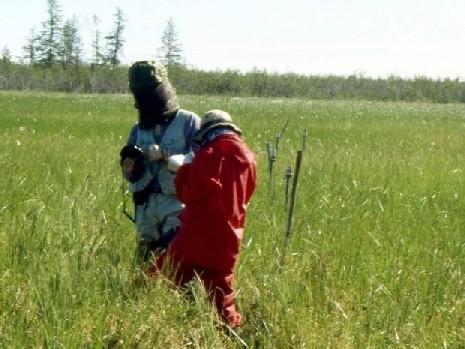 2 2
[1] A knee of Dr. Sato on July 14, 1995, when we surveyed vegetation on ice wedges along Kolyma River. Since I took the photo after many mosquitos escaped, the enemies were not so many. [2] It was fine weather near Kolyma River on July 18, 1995. I measured methane flux with Drs. Sato and formely JR Hokkaido Campaign Girl. We prepared so-called fully-protective wear, including mosquito netting, raincoat, thick gloves, and rubber boots. |
ActionFully protective wear is the best way for health, although we feel sunsick. However, we are exhausted for a short time as if we took a sauna.We usually put DEET (C12H17NO), that is a super-strong rejectant, on our skins when we stay in Alaska. DEET melts plastic. In fact, a band of my wristwatch was denatured. However, we can not stop using DEET like a drug after we understand the overwhelming efficacy. Although we should seek immediate medical attention if the symptom is serious, we may not be able to go any clinics ASAP when we stay in the study sites. It is better that we should prepare accurate medicines. Fam Culicidae (カ科)3000 species in 35 genera. Species and genera in Hokkaido are listed below.Subfam Toxorhynchitinae (オオカ)Toxorhynchites (オオカ): T. towadensis (トワダオオカ), HokSubfamCulicinae (ナミカ)Tripteroides (ナガハシカ)Culex (イエカ): C. pipiens pallens (アカイエカ), Hok. C. pipiens molestus (チカイエカ). C. tritaeniorhynchus (コガタアカイエカ) Aedes (ヤブカ): A. togoi (トウゴウヤブカ). A. japonicus japonicus (ヤマトヤブカ) Anopheles (ハマダラカ): A. lesteri (オオツルハマダラカ). A. sinensis (シナハマダラカ) |
Most bees (wasps and hornets) do not always sting people. However, bees may attack people to protect their nests. Watch out during the Bon holidays and fall when the colony size of hornets increases in the nest.
| bee | both | wasp | |
|---|---|---|---|
| Stinger | honeybee workers: stinger is pulled from the abdomen other bees: live to sting again | have backward-pointed barbs on stinger to penetrate victim | small barbs; stinger can be removed from victim; wasp lives to sting again |
| Body | rounder body, usually appears hairy | narrow junction between thorax and abdomen | usually slender and smooth |
| Leg | hairy | few hairs | |
| Food | feed on pollen and nectar | predators or parasites of other insects, or scavengers |
I poked something like a dung by a stick in Abashiri, because I thought the insects around the dung were flies. I was slow to realize that it was wasp! Oh boy.
• First Aid for Bee and Insect Stings
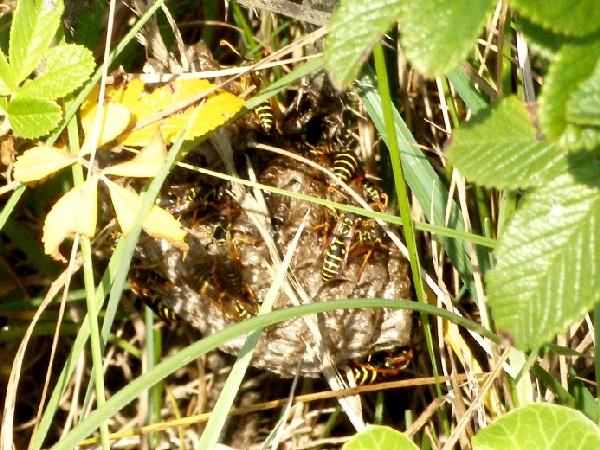 1
1
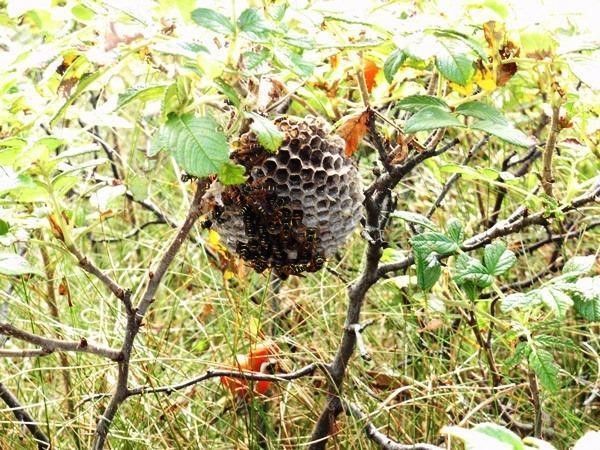 2
2
[1] A wasp nest hidden in a Rosa rugosa bush in Field trip for life environments conducted at Kunebetsu Seacoast, Hokuto City, on September 25 2009. More nests were found. [2] We found out two nests at the same place on September 22 2010.